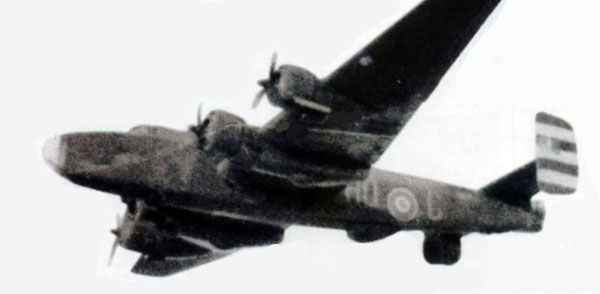
On the night of 3rd / 4th March 1945 the crew of this 466 Squadron aircraft took off from Driffield airfield at 18.23hrs to undertake an operational flight to bomb Kamen. The 466 Squadron crews bombed the target area through 10/10th cloud but onto the PFF markers and made for home. This specific aircraft (pictured above) bombed from 20,000 feet at 22.03hrs. Of the 466 Squadron aircraft that undertook this operational flight all the aircraft returned to circuit of Driffield and eleven had landed by the time the enemy intruder attacks started. Driffield airfield then effectively shut and the airfield lighting would have been switched off, with their aircraft being diverted away to land elsewhere. Of their six aircraft still in the air one landed at nearby Carnaby, one crashed at Skellingthorpe (Lincolnshire) and the other three landing at Croft, Leeming and Middleton St.George. One of the survivors of the eventual crash of Halifax NR179 would later recount his memories of this night, he stated that as they were about to land at Driffield there was a problem on the ground with the aircraft that had been ahead of them. The instruction to overshoot the landing was given and this Halifax climbed away but at this stage they had only a small amount of fuel left. This crew (and some of the other remaining 466 Squadron aircraft in the air) appear to have initially been diverted west towards the York area (to land at either Elvington, Pocklington or Melbourne?) but when they arrived in that area these airfields had then shut down because of the enemy aircraft making attacks there. Other 466 Squadron Halifaxes that had not landed appear to have then joined what was left of the airborne Elvington, Pocklington and Melbourne aircraft and went north towards the 6 Group airfield area. As Halifax NR179 was running low on fuel the intention of the pilot was not to go north but to climb and head back east again before baling out nearer the coast. I have been unable to discover exactly where Halifax NR179 was attacked at 00.49hrs. It may have been in the Elvington area as around the same time Halifax NR235 was also attacked, or similiarily over the Yorkshire Wolds as Halifax PN437 was attacked near Sledmere. By all accounts there were Junkers Ju88's generally flying all over the Vale of York and Yorkshire Wolds around 01.00hrs so it could have been anywhere. With control being lost and the fuselage being on fire the pilot ordered the crew to bale out, three of the crew were able to make good escapes from the rear escape hatch and land safely by parachute. The pilot and three other members of the crew either jumped too late and their parachutes did not open or unfortunately did not get clear of the aircraft and were killed, possibly as a result of the front escape hatch being jammed. The aircraft crashed at around 01.00hrs believed to have been in the Fridaythorpe area of the Yorkshire Wolds.
Researching where this aircraft crashed using the usual contemporary sources the location remains less clear. In more modern listings the location for this incident Fridaythorpe is quoted. Fridaythorpe is roughly mid-way between Driffield and Pocklington, and on the Yorkshire Wolds. This is probably the crash location as the 466 Squadron ORB states the incident occurred "near base" (of Driffield) and it would fit for Fridaythorpe. However, in trying to locate contemporary documentation to confirm this I have come across references in the RAAF casualty files which states that this NR179 crashed near Sutton upon Derwent (near Elvington) and that F/Sgt Laing was then admitted to Elvington airfield's sick quarters. The death registrations of those who died in NR179 were registered in the Howden district (which would fit for near Sutton upon Derwent). If NR179 crashed at Fridaythorpe the deaths would probably not have been registered in the Howden district and for F/Sgt Lain to have been taken to Elvington for treatment whoever took him there from the general Fridaythorpe area would have had to drive past Pocklington airfield. The survivor's account stated there was less than a minute from the aircraft catching fire to the aircraft hitting the ground so those who baled out must have landed reasonably close by but he does not mentions where he landed unfortunately. Halifax NR235 is listed as having crashed near Sutton upon Derwent with the loss of the Free French pilot on this night, his death was also registered as having occurred in the Howden district. The death registrations are seldom incorrect. Perhaps with the confusion of what was going on during this night NR179 did indeed crash at Fridaythorpe and somehow it was partly recorded as having crashed where Halifax NR235 crashed at Sutton upon Derwent. Another possibility is that the aircraft was attacked over the Elvington area and somehow managed to limp off east with part of the crew baling out over the Elvington area and the aircraft crashing nearer Fridaythorpe. Given the witness stating there was only forty seconds between the aircraft catching fire and crashing this would seem unlikely.
Perhaps more information is required to 100% confirm exactly where Halifax NR179 came down. Given the events of this night have been well documented both in books and on websites no-one appears to have ever come to any firm conclusion where this aircraft actually crashed, I find this unique for fatal flying accidents in Yorkshire in 1945. Historians Eric Barton and Ken Reast located small remains of a Halifax near Fridaythorpe in the early 2000s which they attribited to NR179. A memorial near the Fridaythorpe crash site was dedicated in more recent years.
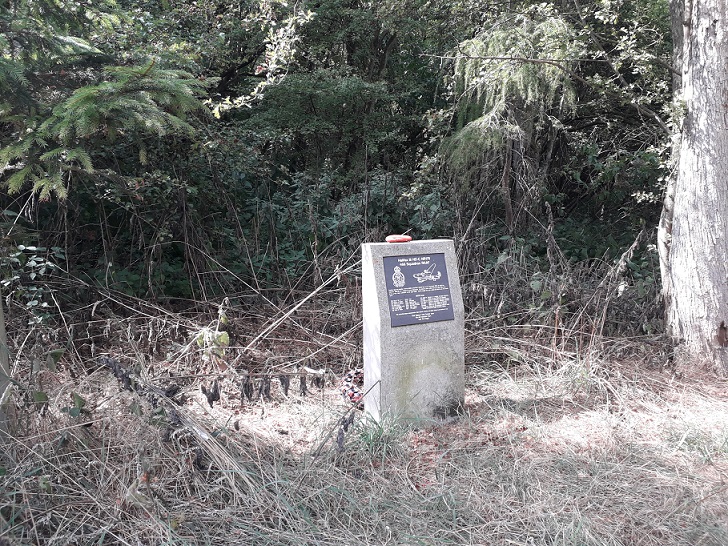
On 25th May 2018 a commemoration and remembrance ceremony took place at Gill's Farm, Fridaythorpe which would suggest that the aircraft crashed there.
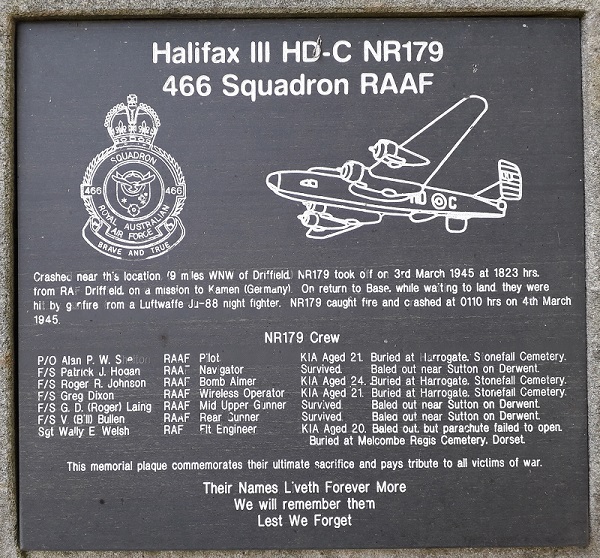
Pilot - F/O Alan Percy William Shelton RAAF (428602), aged 21, of Elsternwick, Victoria, Australia. Buried Harrogate Stonefall Cemetery, Yorkshire (H/H/5).
Flight Engineer - Sgt Walter Edward Welsh RAFVR (1606174), aged 20, of Piddlehinton. Buried Melcombe Regis Cemetery, Dorset.
Bomb Aimer - F/Sgt Roger Robert Johnson RAAF (437965), aged 24, of Kew, Victoria, Australia. Buried Harrogate Stonefall Cemetery, Yorkshire (H/H/4).
Wireless Operator / Air Gunner - F/Sgt Gregory Wills Dixon RAAF (428968), aged 21, of Chatswood, New South Wales, Australia. Buried Harrogate Stonefall Cemetery, Yorkshire (H/H/6).
Navigator - F/Sgt Patrick Joseph Hogan RAAF (436464). Uninjured.
Air Gunner - F/Sgt Graham Dodge Laing RAAF (115148). Slightly injured, sprained ankle on landing.
Air Gunner - F/Sgt Vivian Donald "Bill" Bullen RAAF (431933). Minor injuries on landing.
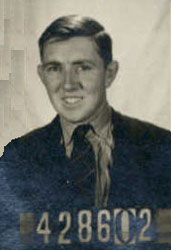
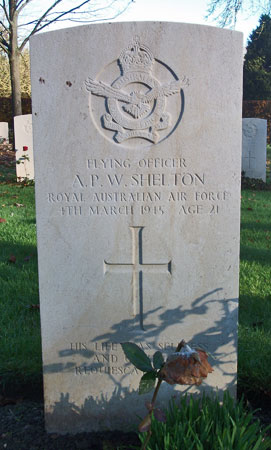
Alan Shelton was born on 18th April 1923 at Melbourne, Victoria, Australia and was the son of Dr Percy Gerald and Mrs Lily Shelton. Alan was a medical student when he enlisted into the RAAF on 27th November 1942 at Melbourne and after basic training was awarded his pilots' flying badge on 23rd September 1943. On arrival in the UK he trained at 20 (P)AFU, 27 OTU and 1658 HCU, he received a commission on 10th September 1944 and he and his crew were then posted to 466 Squadron on 19th January 1945.
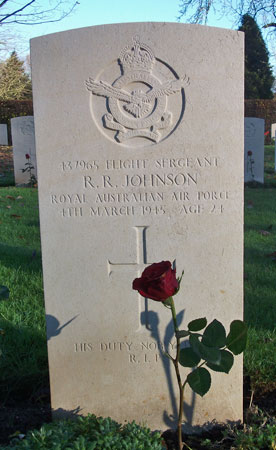

Roger Johnson was born on 5th June 1920 at Melbourne, Victoria, Australia and enlisted for RAAF service there.
Gregory Dixon was born on 20th March 1923 at Strathfield, New South Wales, Australia. He enlisted for RAAF service in Sydney on 22nd October 1942.
Patrick Hogan was born on 8th April 1922 at Bendigo, Victoria, Australia and enlisted for RAAF service in Perth.
"Bill" Bullen was born on 18th May 1919 in Bendigo, Victoria, Australia. He had initially served in the Australian Army and saw service in North Africa before switching to air force service.
Graham Laing was born on 13th April 1924 at Medindie, South Australia and was the son of Charles Robert and Mabel Ida (nee Rossiter) Laing. He was working as a truck driver when he initially enlisted for RAAF service in 1940 but his employer would not grant him to enlist. He re-enlisted for RAAF service on 21st July 1942 at Adelaide and this time his employer relented. He originally underwent training to be a fitter as a member of ground crew but remustered as aircrew in 1943. After training he was awarded his air gunners' flying badge on 16th March 1944. He left the RAAF after the War.